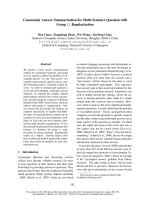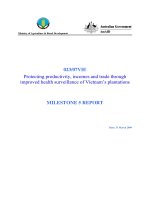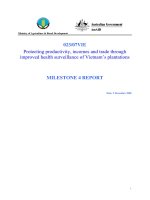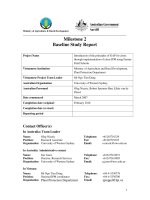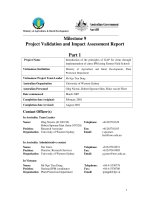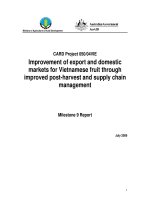Course Project Stroke Prediction Group 18 Report.pdf
Bạn đang xem bản rút gọn của tài liệu. Xem và tải ngay bản đầy đủ của tài liệu tại đây (5.89 MB, 30 trang )
<span class="text_page_counter">Trang 1</span><div class="page_container" data-page="1">
Hanoi University of Science and Technologies IT3190-123220 Machine Learning
Semester 20202
Course ProjectStroke Prediction
</div><span class="text_page_counter">Trang 3</span><div class="page_container" data-page="3">DenitionProject overview
Stroke is one of the major causes of death.
In this project, we’re building a model capable of early predicting whether a patient is likely to get astroke or not. The prediction is made by learning from thousands of patients. Each patient’sinformation includes gender, age, smoking status, hypertension status, marital status, etc.
Instead of building everything from scratch, we’ll take advantage of various tools from theScikit-learn, Pandas, Numpy, Imbalanced-learn library. This is due to 2 reasons:
1. We don’t have enough time to build everything from scratch. Indeed, we’d tried and canceledbecause this took a big chunk of our time before we actually got round to the Stroke prediction.2. Our goal is to get familiar with doing experiments in DS and ML, understand the workow of aproject and get an insight from the dataset as well as dierent algorithms.
We select CART, SVM, ANN algorithms in this project.
Problem Statement
The tasks involved are the following:
1.
Download the Stroke dataset from Kaggle:<small> Do basic data preparation including data cleaning.3. Test the impact of dierent data transforming and sampling techniques on each model’sperformance.
4. Tune each model’s parameters
5. Compare among 3 models on the nal prediction.
</div><span class="text_page_counter">Trang 4</span><div class="page_container" data-page="4">Test Option and Evaluation Metric
We’ll use Repeated Stratied 5-fold Cross Validation to estimate F1 score.𝐹<sub>1</sub>= 2 <small>𝑃𝑟𝑒𝑐𝑖𝑠𝑖𝑜𝑛×𝑅𝑒𝑐𝑎𝑙𝑙</small>
<small>𝑃𝑟𝑒𝑐𝑖𝑠𝑖𝑜𝑛 + 𝑅𝑒𝑐𝑎𝑙𝑙</small>
Where𝑃𝑟𝑒𝑐𝑖𝑠𝑖𝑜𝑛 = <sub>𝑇𝑟𝑢𝑒 𝑃𝑜𝑠𝑖𝑡𝑖𝑣𝑒 + 𝐹𝑎𝑙𝑠𝑒 𝑝𝑜𝑠𝑖𝑡𝑖𝑣𝑒</sub><sup>𝑇𝑟𝑢𝑒 𝑃𝑜𝑠𝑖𝑡𝑖𝑣𝑒</sup> and𝑅𝑒𝑐𝑎𝑙𝑙 = <sub>𝑇𝑟𝑢𝑒 𝑃𝑜𝑠𝑖𝑡𝑖𝑣𝑒 + 𝐹𝑎𝑙𝑠𝑒 𝑁𝑒𝑔𝑎𝑡𝑖𝑣𝑒</sub><sup>𝑇𝑟𝑢𝑒 𝑃𝑜𝑠𝑖𝑡𝑖𝑣𝑒</sup>This metric is selected because our dataset is severely imbalanced. (see Fig. 1)
Fig. 1: `Stroke` distribution(“class_distribution.png”).
accounts for 4861 records(95.1%) and 1 accounts for249 records (4.9%). Thisshows that our data is severelyimbalanced.
This is benecial in 2 ways:
1. Avoid misleading evaluation results: A 5-fold cross validation is appropriate for an imbalancedataset because a fold is ensured to be a representative sample of the domain. F1 score isconsidered to be a proper measure for severely imbalanced classication .
2. Explain our desire: In our specic problem, “stroke” is positive class, we would prefer to haveboth Precision and (especially) Recall as high as possible, which means we’ll implement inorder that F1 could be as high as possible.
During the training process, we use a validation set extracted from 10-time Repeated Stratied 5-foldCross Validation.
4
</div><span class="text_page_counter">Trang 5</span><div class="page_container" data-page="5">AnalysisData Exploration
The Stroke dataset has 5110 records, each record has the following elds:
❖ gender "Male", "Female" or "Other" (string)❖ age age of the patient (oat). Min: 0.08, Max: 82.0
❖ hypertension 0 for not having hypertension, 1 for having hypertension (int)❖ heart_disease 0 for having heart diseases, 1 for having heart disease (int)❖ ever_married "No" or "Yes" (string)
❖ work_type "children", "Govt_jov", "Never_worked", "Private" or "Self-employed"(string)
❖ Residence_type "Rural" or "Urban" (string)
❖ avg_glucose_level average glucose level in blood (oat). Min 55.12, Max: 271.74
❖ smoking_status "formerly smoked", "never smoked", "smokes" or "Unknown" (string)❖ stroke 1 if the patient had a stroke or 0 if not (int)
Each of these attributes is observed in 5110 records, except for `bmi` which have 4909 recordsobserved. This implies that `bmi` is having a fair number of missing values.
By observing the uniques values of each attributes, we can easily split these attributes into:❖ Numerical variables: `age`, `avg_glucose_level`, `bmi`
❖ Categorical variables: `smoking_status`, `gender`, `hypertension`, `heart_disease`,`ever_married`, `work_type`, `Residence_type`
Exploratory Visualization
All data visualizations are done in “data_visualization.ipynb”. Down here we show some guresworth mentioning.
</div><span class="text_page_counter">Trang 6</span><div class="page_container" data-page="6">Fig. 2: Box and whisker plots for `age`, `avg_glucose_level`, `bmi` (“boxplot_before.png”).
We pay attention to the `bmi` whose several records are quite far from others. This suggests theycould be outliers and possibly need removal (See the Data Preparation section).Fig. 3: Scatter pairplot with respect to `stroke` attribute (“pairplot.png”). **Note**: all values 0 of stroke are putBEHIND values 1 before plotting, indeed they OVERLAP each other.
By eye, we can’t nd any single attribute that can clearly classify `stroke`. The only characteristic wecan realize is that: most stroke patients whose `age` is greater than 50 and whose `bmi` is smaller than50.
Algorithms and Techniques
I. Classication and Regression Tree (CART)
CART is available in DecisionTreeClassier in Scikit-learn, is one of the most widely-usedalgorithms in supervised learning. CART requires very little data preparation. It can workwith both numerical and categorical variables, handle missing values, robust to noise, andcapable of doing feature selection automatically. However with Scikit-learnDecisionTreeClassier does not support handling missing values and categorical variables ifthey are not in numeric form.
The following parameter can be tuned to optimize DecisionTreeClassier:
6
</div><span class="text_page_counter">Trang 7</span><div class="page_container" data-page="7">❖ splitter: Decision trees tend to overt on data with a large number of features. However, itcan do feature selection automatically by setting splitter=“best” (which bases on (Im)purity).Another value is “random”. If we have hundreds of features, “best” is preferred because“random” might result in features that don’t give much information, which lead to a deeper,less precise tree.
❖ max_depth: This indicates how deep the tree can be. The deeper the tree, the more splits ithas and it captures more information about the data. However, max_depth needs controllingto prevent overtting.
</div><span class="text_page_counter">Trang 8</span><div class="page_container" data-page="8">❖ min_samples_split: The minimum number of samples required to split an internal node.When min_samples_split increases, the tree becomes more constrained.
❖ min_samples_leaf: The minimum number of samples required to be at a leaf node. At anydepth, regardless of min_samples_split, a split point can only be accepted if each of its leaveshave at least min_samples_leaf samples.
❖ max_features: The maximum number of features to consider when looking for the best split.❖ ccp_alpha: Cost-complexity pruning alpha is used to post-pruning the tree in order to avoid
overtting. It denes cost-complexity measure R(T)=R(T) +T where R(T) is the totalmisclassication rate of leaf nodes and |T| is the number of leaf nodes. The nodes with thesmallest eective alpha are pruned rst.
II. Support Vector Machines (SVMs):
SVMs are useful techniques for data classication. It is known for its accuracy, stability andspeed. Also, it is considered easier to use than Neural Networks. the SVC (C-based SVM) ofScikit-learn is chosen to implement the SVM algorithm for this problem
These are the parameters of SVC:
❖ C: Penalty parameter of the error terms, dene how much the model penalizes for an error. Itis also called the Regularization parameter, which is inversely proportional to the strength ofregularization to the model.
❖ kernel: Kernel type to be used in the algorithm. Can be one of: Linear, Polynomial, RBF orSigmoid
❖ gamma, coef0, degree: Each kernel requires at least one of these parameters (except theLinear)
❖ class_weight: A dictionary to specify weight for each class. If specied, the parameter C ofclass i will be modied to class_weight[i]*C. The purpose of this is to handle unbalanceddataset.
III. Articial Neural-Network (ANN):
ANN is known to be eective in classication problems. Another point is that ANN isadaptive with uncleanse data and future missing data - which might probably happen withthis problem. However, ANN has a critical drawback that it cannot show the process ofmaking predictions clearly (It works somewhat similarly with the human brain - at a lower8
</div><span class="text_page_counter">Trang 9</span><div class="page_container" data-page="9">level). Fortunately, in this problem, the results are more important and users might not reallyneed to know about how the decisions are made.
In the scope of this problem, we use the Multi-layer Perceptron Classier (MLPClassier) ofsklearn to learn. This model has several parameters to tune up such as:
❖ hidden_layer_sizes❖ activation❖ Solver❖ Alpha❖ Batch_size❖ ...
However, the easiest-to-observe parameters are hidden_layer_sizes and max_iter whichindicate the number of hidden layers and maximum number of iterations. Those information alsodemonstrate the complexity of the model and aect vastly on model performance.
</div><span class="text_page_counter">Trang 10</span><div class="page_container" data-page="10">MethodologyData Preparation
In this Machine Learning course, we’re not going to spend much energy in data preprocessing,because it seems more relevant to the Data Science course. Instead, we’ll mostly focus onmodel-centric.
The preparation steps are:
❖ Impute missing values by a simple decision tree model
❖ Split the dataset into a training set and test set (using Stratied train_test_split).❖ Do data transformation (Encode categorical variables & Scale numerical variables).
Data sampling
Severely imbalanced dataset might degrade a model's performance. The model is often biased towardthe majority class, and the minority class is harder to learn. One approach to deal with imbalanceclassication is applying oversampling and undersampling techniques.
10
</div><span class="text_page_counter">Trang 11</span><div class="page_container" data-page="11">Fig. 4: Scatter plot for data distribution after oversampling (oversampling.png). The originaldistribution looks the same as the gure of RandomOverSampler. #stroke:#not_stroke is set at 3:10for all techniques. **Note**: all markers of 0 are put BEHIND all markers of 1 before plotting,indeed they OVERLAP each other.
Fig. 5: Scatter plot for data distribution after undersampling (undersampling.png).#stroke:#not_stroke is set at 3:10 for RandomUnderSampling. **Note**: all markers of 0 are putBEHIND all markers of 1 before plotting, indeed they OVERLAP each other.
</div><span class="text_page_counter">Trang 12</span><div class="page_container" data-page="12">❖ Tune model and plot the results for the train set and validation set.
In the implementation with CART algorithm, we’ve done many experiments. However, for the sakeof a brief report, we’ll just refer to notable results and skip the others. For complete experimentalresults, please read cart.ipynb.
After reading articles, we’re recommended to use sampling to balance data. We’ve done experimentswith both oversampling and undersampling. In Fig. 6, we summarize the experimental result. Fig 6demonstrates the general results of eects of dierent sampling techniques on CART model.Data sampling is intuitively believed to improve decision tree’s performance because the classassigned to a leaf node is aected by the number of instances from each class in that leaf. In ourproblem, we certainly want our CART to be more sensitive to `stroke` instances for the sake of earlywarning. If we don’t oversampling or undersampling, the portion of `stroke` instances in a leaf mightbe too low, which causes more bias toward `not stroke` instances.
12
</div><span class="text_page_counter">Trang 13</span><div class="page_container" data-page="13">Fig. 6: Eect of sampling on CART. Model used: Random oversampling, SMOTE, SVM SMOTE,Borderline SMOTE, Random undersampling, One-sided selection, Neighbourhood cleaning rule,SMOTE Tomek, SMOTE Edited nearest neighbour. #stroke:#not_stroke is set from 0.1 to 0.9 forall sampling models, except OSS and NCR.
After many runs, SMOTE ENN shows the most promising scenario. This is unsurprising becausebeside balancing data via SMOTE, the technique also pays attention to the unambiguity of examplesin the data set and increases the certainty of decision boundaries.
SMOTEENN. #stroke:not_stroke is set at3:10. **Note**: all markers of 0 are putBEHIND all markers of 1 before plotting,indeed they OVERLAP each other.
</div><span class="text_page_counter">Trang 14</span><div class="page_container" data-page="14">We can clearly see in the top right of Fig. 7 , in combination with extending the coverage of strokeinstances, a lot of majority-class examples around the area covered by minority class are removed,which may help increase Recall while not decreasing Precision much.
According to some articles, a subeld of machine learning called cost-sensitive learning can beapplied to solve the problem of imbalance classication. This can be carried out with CART bycontrolling the `class_weight` parameter in Scikit-learn DecisionTreeClassier. Basically, the weightof each instance in a leaf node will account for the class determination of that leaf. In ourexperiment, we tested dierent class weights, where stroke_weight:not_stroke_weight ranges from1:1 to 23:1. However, the performance of CART does not change, as illustrated in Fig.8, which issurprising.
Fig .8: Class weight tuning forCART. #stroke:#not_strokeranges from 10:1 to 35:1.
Ultimately, after several further experiments, we decided to choose SMOTENN with ratio 0.3 in therest of the project, for the step of data transforming and parameter tuning.
The next major experiments involve comparing Ordinal vs Onehot encoding, and the dierencebetween the two’s impact on the performance is very little. In general, with categorical variables,onehot encoding is seemingly more preferred as it does not create additional relationships. However,with decision trees, some articles claim that onehot encoding degrades the performance as it createsmany more variables with less feature importance. Unfortunately, we could not justify these claimsin this project. In Fig. 9, the performance of CART model on these encoding strategies does notdier much, seemingly because our dataset has only 11 columns and they do not separate examples14
</div><span class="text_page_counter">Trang 15</span><div class="page_container" data-page="15">well. Another experiment we do is testing if discretization is good for our problem because decisiontrees prefer discrete variables. However, the performance of CART degrades after discretization.Again, we could not explain, and for the sake of a brief report we leave source code and gure incart.ipynb.
Fig. 9: Encoding strategies’impact on CART. Average F1score for Ordinal is 0.212643,and for Onehot is 0.214212.
The next step is tuning parameter of CART. We’ve chosen `splitter`, `min_samples_split`,`min_samples_leaf`, `max_depth`, `max_features`, `ccp_alpha`. For the sake of a brief report, we’llmention the most notable results only. You can view the complete result in cart.ipynb.
Concisely, by utilizing grdd search, we found a good combination of `min_samples_split`,`min_samples_leaf`, which slightly improved the performance of CART. With that combination, wecontinue to tune `max_depth` and `ccp_alpha`. Fig. 10 illustrates the experiment.
</div><span class="text_page_counter">Trang 16</span><div class="page_container" data-page="16">Fig. 10: `max_depth` (left) and `ccp_alpha` (right) tuning. `max_depth` ranges from 0 to 30 and`ccp_alpha` ranges from 0 to 0.05. **Note**: data sampling on the training set is done before tuning(mentioned above).
`max_depth` performs pre-pruning and `ccp_alpha` performs post-pruning. At rst glance, it’stempting to choose `max_depth` = 5 or `ccp_alpha` in range (0.01, 0.02) because they make F1signicantly hike up. However, as we plot the data on each `max_depth` and `ccp_alpha` value (seeFig. 11), the smaller `max_depth` and the higher `ccp_alpha` makes prediction more unreal. In case`max_depth` < 5 or `ccp_alpha` > 0.006, we clearly see that CART is far less exible, almost allexamples with `age` > 70 or `avg_glucose_level` > 200 are labeled as stroke. Though the recall couldbe very high, we have to compromise with precision.
Fig. 11: Scatter plot dataset with `max_depth` (=1 and =5) and with `ccp_alpha` (=0.006, =0.007,=0.008). The top left gure is for true classication of the training set.
16
</div>